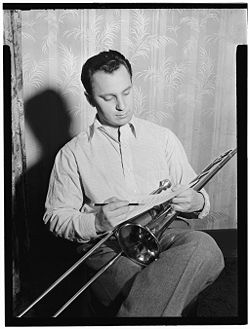Buddy Morrow
Buddy Morrow (* 8. February 1919 in New Haven , Connecticut ; † 27. September 2010 in Raleigh (North Carolina) ; actually Muni Zudekoff called Moe Zudekoff ) was an American jazz - trombonist and leader of a Swing - big band .
Life
Buddy Morrow studied at the Juilliard School of Music and began his career in 1936/37 under his maiden name in Artie Shaw's band ; as Mini Morrow he played in 1941/42 with Bob Crosby . From 1946 to 1950 he was a member of the Tommy Dorsey Orchestra, in 1949 he worked for Flip Phillips . When the big band era came to an end, RCA Victor was looking for a successor to Tommy Dorsey's band, which had previously recorded for the label; from then on Morrow led (next to Ralph Flanagan ) his own band for RCA and; this had its headquarters in New York, where it usually appeared in the Roseland Ballroom . Otherwise she toured mainly in the Midwest and also in the southern United States, where she made a guest appearance at the Roosevelt in New Orleans . Morrow recorded a number of albums for both RCA and Mercury ; He became known in the national charts for his interpretations of the titles "Rose, Rose, I Love You" 1951, # 8), "Night Train" (1952, # 27), "Greyhound" (# 30, 1952), "One -Mint Julep "(# 30, 1952)," Train, Train, Train "(# 14, 1953)," Mister Sandman "(# 20, 1954) and his ballad play. Members of his bands in 1951/52 included Yank Lawson , Lou McGarity , Bob Haggart and in 1955 for a time the bassist Scott LaFaro .
In the early 1960s, Morrow could only perform with his band on weekends; he then worked mainly as a studio musician in the New York area, such as in 1969 with the album Chapter Threee: Viva Emilio Zapata by Gato Barbieri ; In 1970 he was a member of the Count Basie Orchestra . In the late 1970s he led the Tommy Dorsey Orchestra as the Ghost Band , with whom he toured. In 1975 he worked with Joe Thomas ; In 1988 he played in Erich Kunzel's Cincinnati Pops Big Band Orchestra .
Discographic notes
- Buddy Morrow, his Trombone, and His Orchestra - A Big Band Buddy: Studio and Live Recordings, 1945–1957 (Jasmine Records, 2004)
- Buddy Morrow On RCA (RCA, 1950-53)
- A Salute To The Fabulous Dorseys (Universal, 1955)
- Music For Dancing Feet (Universal Recorders, 1955)
- Buddy Morrow and His Golden Trombone (Universal Recorders, 1956)
- Big Band Beatlemania (the big hits of 1964) ( Epic )
- Big band guitar ( RCA Victor , 1959)
- Swingin 'Through the Night, ( Bluebird Records )
- The Uncollected Buddy Morrow (Hindsight, 1964) with Stan Edson
literature
- John Chilton : Who's who of Jazz. Storyville to Swing Street. 4th edition. Macmillan, London 1985, ISBN 0-333-38478-4 .
- Donald Clarke (Ed.): The Penguin Encyclopedia of Popular Music. Viking, London et al. 1989, ISBN 0-670-80349-9 .
- Chip Deffaa: In the mainstream. 18 portraits in jazz (= Studies in Jazz. No. 11). The Scarecrow Press, Metuchen NJ et al. 1992, ISBN 0-8108-2558-9 .
- Barry Kernfeld (Ed.): The New Grove Dictionary of Jazz. Volume 2: L - Z. Macmillan et al., London et al. 1988, ISBN 0-333-39846-7 .
- Colin Larkin (Ed.): The Guinness Encyclopedia of Popular Music. Guinness Publishing, Enfield 1992, ISBN 0-85112-939-0 .
- Colin Larkin (Ed.): The Encyclopedia of Popular Music. Volume 5: Louvin, Charlie - Paul, Clarence. 3. Edition. Macmillan et al., London et al. 1998, ISBN 1-561-59237-4 .
- George T. Simon : The Big Bands. Simon and Schuster, New York NY et al. 1967 (4th edition. Schirmer Books et al., New York NY et al. 1981, ISBN 0-02-872430-5 ; German: Die goldene Ära der Bigbands. From the American by Josef Horatschek. Editorial revision by Henning Dedekind, Koch-Hannibal publishing group, Höfen 2004, ISBN 3-85445-243-8 ).
- Leo Walker: The Big Band Almanac. Ward Ritchie Press, Pasadena CA 1978, ISBN 0-378-01991-0 .
Web links
- Portrait and discography at spaceagepop
- Brief portrait at glennmillerorchestra.com
- Buddy Morrow productions website
- Obituary in The New York Times
Individual evidence
| personal data | |
|---|---|
| SURNAME | Morrow, buddy |
| ALTERNATIVE NAMES | Zudekoff, Moe (nickname); Zudekoff, Muni (real name) |
| BRIEF DESCRIPTION | American jazz trombonist and band leader |
| DATE OF BIRTH | February 8, 1919 |
| PLACE OF BIRTH | New Haven , Connecticut , USA |
| DATE OF DEATH | September 27, 2010 |
| Place of death | Raleigh, North Carolina |
